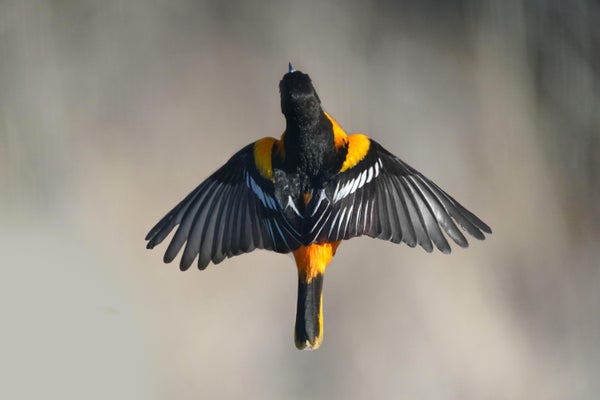The same solar storms that can paint the polar skies with dancing lights might also interfere with a very different phenomenon: bird migration.
Nocturnally migrating birds are less likely to fly—and in some cases, more likely to drift where the winds take them—during space weather events that disturb the magnetic field that surrounds our planet. That’s the same field that, among other cues, birds use to guide their paths, according to research published on Monday in the Proceedings of the National Academy of Sciences USA. The study focused on birds that move at night, as most migrators do, particularly perching birds such as warblers, thrushes and sparrows.
“We really didn’t know what we would find at all, because at face value, [linking] space weather and bird migration sounds kind of wacky,” says Ben Winger, an ornithologist at the University of Michigan and senior author of the new research paper. “But we do know that birds use the magnetic field, and the magnetic fields do get disrupted, so there ought to be a relationship.”
On supporting science journalism
If you're enjoying this article, consider supporting our award-winning journalism by subscribing. By purchasing a subscription you are helping to ensure the future of impactful stories about the discoveries and ideas shaping our world today.
Space weather includes the solar wind of charged particles that constantly streams across the solar system; coronal mass ejections that send blobs of the sun’s plasma into space; and solar flares that shoot bursts of radiation from our star.
Earth’s magnetic field swathes our planet in a protective bubble that blunts the worst of the sun’s outbursts, but strong events can still affect human infrastructure such as GPS satellites and power grids. And some of this weather can affect the magnetic field in ways that are not perceptible to humans.
Typically, studies of magnetic sensing in birds have focused on individual animals and have tested how they responded to exposure to an artificial magnetic field, for example, or a fake night sky with star positions that didn’t match their magnetic location. But Winger and his colleagues decided to look at bird behavior in real life and on a much larger scale by using data generated by radar stations employed for weather forecasting. During spring and fall migrations, birds take to the sky in such quantity that radar stations can tally the number of animals in flight.
When the researchers compared 23 years’ worth of radar data from across the central U.S. with magnetic field measurements from the stations, the scientists found a noticeable decrease in the sheer number of birds migrating on nights with high geomagnetic activity.
“I’m not surprised that disturbance in the field has an effect,” says Marilyn Ramenofsky, a behavioral endocrinologist at the University of California, Davis, who specializes in bird migration and was not involved in the new research.
Winger and his colleagues looked at spring and fall migrations separately and factored in each night’s cloud cover because birds are also known to use the stars to navigate, among other resources. In general, the birds seemed to be more sensitive to space weather disturbances in the fall—when they would have faced less pressure to arrive promptly and when the year’s hatchlings would have been making their first migration—as well as on cloudy nights, the researchers found.
“It shouldn’t be surprising to us that they can respond and that they’re flexible and that this doesn’t show them for a complete loop and that they use other cues,” Ramenofsky says. “There’s so much information out there, and birds tend to use it all.”
Both she and others noted, however, that the study only identified a potential association between magnetic field disturbances and bird behavior. It’s possible that some third variable is affecting both. “With correlations, it’s always very hard to draw conclusions,” says Nele Lefeldt, a neuroscientist at Rice University, who was not involved in the new research. “That being said, this group of scientists definitely did a really good job getting as close as they can to the answer with the means that they had.”
Overall, the study is a reminder to look beyond humans’ sensory capacities when trying to understand the behavior of nonhuman species.
“Humans don’t perceive these magnetic fields, so we don’t perceive a magnetic storm the way we would a weather storm, and so we have no idea that there’s something going on that’s a problem, whereas it turns out that birds are perceiving an actual disturbance,” Winger says. “It suggests that these things happening in space that seem like they’re not relevant to Earth actually are.”
